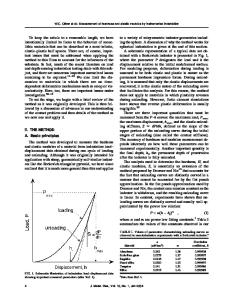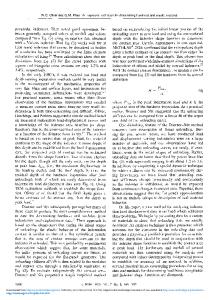Determination of elastic modulus and hardness of viscoelastic-plastic materials by instrumented indentation under harmon
- PDF / 178,432 Bytes
- 10 Pages / 612 x 792 pts (letter) Page_size
- 6 Downloads / 432 Views
. Rauchs, J. Bardon, and A. Riche Centre de Recherche Public Henri Tudor, Laboratoire de Technologies Industrielles, L-4221 Esch-sur-Alzette, Luxembourg (Received 2 February 2005; accepted 26 April 2005)
When determining elastic modulus and hardness of viscoelastic-plastic materials by depth-sensing indentation, one must respect their specific response. In the monotonic load-unload testing mode, the unloading should be preceded by a dwell mitigating the influence of the delayed deforming. The continuous stiffness measurement (CSM) mode, with a small harmonic signal added to the basic monotonic load, enables continuous measurement of harmonic contact stiffness and mechanical properties as a function of depth. However, the contact depth and area in this mode actually depend on the slow (monotonic) component of the loading and should be determined not from the harmonic contact stiffness but from the unloading stiffness; otherwise, the calculated elastic modulus and mean contact pressure will be incorrect. This paper provides the formulae for these calculations, defines special characteristics—such as apparent dynamic hardness and the index of sensitivity to harmonic loading—and shows how to improve results by smoothing the harmonic stiffness curve. The proposed methods are illustrated through nanoindentation tests of polymethyl methacrylate.
I. INTRODUCTION
In instrumented or depth-sensing indentation, contact parameters and mechanical properties are calculated from the indenter load and depth, measured continuously during loading and unloading. This method, called nanoindentation for very low loads and small depths, was originally developed for testing elastic-plastic materials. In this case, the data are usually processed in the manner proposed by Oliver and Pharr,1 which is an improvement on earlier work by Bulychev et al.2 and Doerner and Nix.3 Since then, further improvements have followed. Comprehensive reviews of the current state have been prepared by Hay and Pharr4 and recently by Oliver and Pharr.5 Currently, two variants of the method are in use: (i) with monotonic loading and unloading, where the elastic modulus and hardness are determined from the unloading curve, and (ii) continuous stiffness measurement mode a)
Address all correspondence to this author. e-mail: [email protected] DOI: 10.1557/JMR.2005.0338 2660
J. Mater. Res., Vol. 20, No. 10, Oct 2005
(CSM), where a small harmonic signal is added to the monotonically increasing basic load. The latter method makes possible the continuous determination of properties during loading from “zero” to the maximum force. This can be especially useful for specimens whose properties change with depth since the variation of properties with depth can be obtained through a single test. Gradually, the instrumented indentation has also been used for viscoelastic-plastic materials, e.g., polymers, creeping metals, or biological tissues, whose response depends not only on the load magnitude, but also on the load duration and time course. The load response of th
Data Loading...










